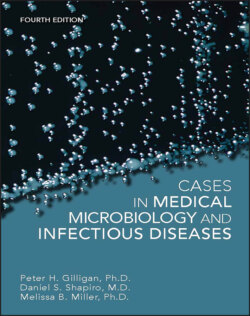Читать книгу Cases in Medical Microbiology and Infectious Diseases - Melissa B. Miller - Страница 72
CASE 11
ОглавлениеA previously healthy 9-month-old infant presented in mid-February with a 2-day history of irritability, fever, and upper respiratory congestion. The mother reported that over the previous 24 hours the child had difficulty breathing with coughing and wheezing. The child’s medical history included a normal delivery after a 9-month gestation without complications. She was up to date on all immunizations. At age 6 weeks the child was placed in a day care center so that the mother could return to work. Several of the infants at the center had been ill recently with colds, and one infant required hospitalization because of severe breathing problems.
On examination the child appeared agitated and had a temperature of 38.6°C. She had both tachypnea (respiratory rate of 70 per minute) and tachycardia (pulse, 200 beats/min). The ears, eyes, and throat were normal except that the oral mucous membranes and tongue were dry. The nasal mucosa was boggy with clear discharge. The lungs revealed diffuse inspiratory and expiratory wheezes. Findings from the rest of the examination were normal.
A chest radiograph revealed hyperexpansion of the lungs but no infiltrates. Arterial blood gases revealed hypoxemia and respiratory alkalosis. The child was admitted to the hospital because of moderate respiratory distress. Supplemental oxygen and intravenous fluids were administered along with bronchodilators and systemic corticosteroids. A rapid molecular test performed on a nasopharyngeal swab provided the diagnosis.
1 1. This child presented with bronchiolitis, an acute viral lower respiratory tract illness generally occurring in the first 2 years of life. What viruses can cause this syndrome? What are the epidemiologic clues in this case that makes one of the viruses most likely?
2 2. Describe the epidemiology of the agent causing her infection.
3 3. What characteristics of this virus are important in determining how the virus spreads in the respiratory epithelium? How does the pathogenesis of the virus contribute to the wheezing that often accompanies this infection?
4 4. Describe the diagnostic strategies available for the detection of this agent. Why is it important to establish this diagnosis quickly?
5 5. What prevention strategies exist to avoid initial infection with this virus and to keep it from spreading within the hospital?
6 6. Is specific therapy available to treat this virus?
